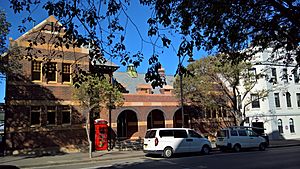Old Coroner's Court, The Rocks facts for kids
Quick facts for kids Old Coroner's Court, The Rocks |
|
|---|---|

Old Coroner's Court Building, 102-104 George Street, The Rocks, NSW
|
|
| Location | 102-104 George Street, The Rocks, City of Sydney, New South Wales, Australia |
| Built | 1906–1908 |
| Architect | Walter Liberty Vernon |
| Architectural style(s) | Federation Free Style |
| Owner | Property NSW |
| Official name: Coroner's Court (former) - Shops & offices; Coroners Court / City Morgue (at rear; demolished); shops and offices | |
| Type | state heritage (built) |
| Designated | 10 May 2002 |
| Reference no. | 1541 |
| Type | Law Court |
| Category | Government and Administration |
| Lua error in Module:Location_map at line 420: attempt to index field 'wikibase' (a nil value). | |
The Old Coroner's Court is a very old and important building in The Rocks, a historic part of Sydney, New South Wales, Australia. It is located at 102-104 George Street. This building was once a special court called a Coroner's Court. It also had offices and, for a time, a morgue at the back.
Today, the building is used for shops and offices. It was also once the Visitors Centre for The Rocks. The building was designed by a famous architect named Walter Liberty Vernon. It was built between 1906 and 1908. This historic site is protected because it is listed on the New South Wales State Heritage Register. This means it's a special part of New South Wales history.
Contents
What is the Old Coroner's Court?
The Old Coroner's Court building has had many uses over the years. It started as a place for the Coroner's Court of New South Wales. A coroner is a special official who investigates deaths that are sudden, unexpected, or unusual. They try to find out why and how someone died.
The Building's Past Uses
The main part of the building was used for the Coroner's Court and offices. This is where important investigations took place. Behind the main building, there was also a morgue. A morgue is a place where bodies are kept temporarily, often for identification or examination.
After its time as a court, the building changed. It became a place for shops and offices. For a while, it also served as The Rocks Visitors Centre. This centre helped tourists learn about the history of the area.
A Look at the Building's Design
The Old Coroner's Court was designed by Walter Liberty Vernon. He was a very important architect in New South Wales. He designed many public buildings around that time.
Federation Free Style Architecture
The building is a great example of a style called "Federation Free Style." This was a popular way of designing buildings in Australia around the time of Federation (when Australia became a nation). This style often uses interesting shapes, different textures, and a mix of materials. It looks strong and grand, fitting for a public building.
The design of the Old Coroner's Court shows how buildings were made in the early 1900s. It has a unique look that makes it stand out in The Rocks area.
Why is This Building Important?
The Old Coroner's Court is important for several reasons. It tells us a lot about the history of law and government in New South Wales. It also shows us how architecture changed over time.
A Heritage-Listed Site
This building is listed on the New South Wales State Heritage Register. This means it is officially recognized as a place of historical importance. Being heritage-listed helps protect the building. It ensures that its history and unique design are kept safe for future generations to see and learn from.
The building is owned by Property NSW. This is a government agency that looks after important properties in New South Wales. They help make sure the building is well-maintained and continues to be a valuable part of The Rocks.
Part of The Rocks History
The Rocks is one of Sydney's oldest areas. It has many historic buildings and stories. The Old Coroner's Court is a key part of this history. It reminds us of the different ways buildings were used in the past. It also shows how areas like The Rocks have changed and developed over many years.

